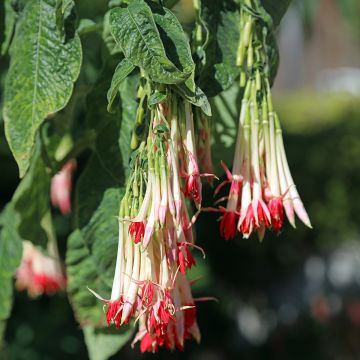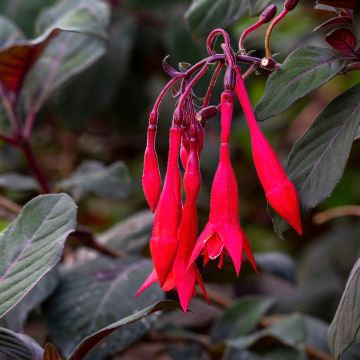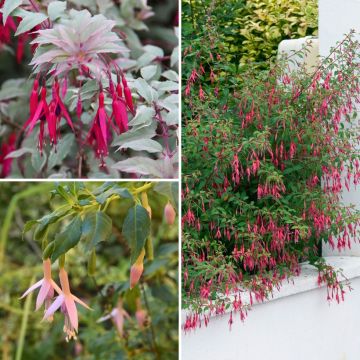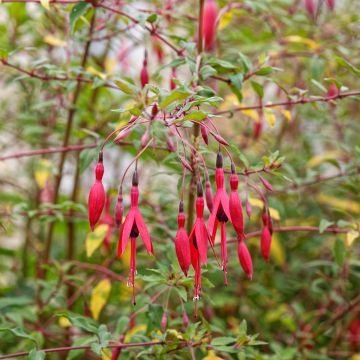

Fuchsia paniculata


Fuchsia paniculata


Fuchsia paniculata


Fuchsia paniculata
Fuchsia paniculata
Fuchsia paniculata
Shrubby Fuchsia
Special offer!
Receive a €20 voucher for any order over €90 (excluding delivery costs, credit notes, and plastic-free options)!
1- Add your favorite plants to your cart.
2- Once you have reached €90, confirm your order (you can even choose the delivery date!).
3- As soon as your order is shipped, you will receive an email containing your voucher code, valid for 3 months (90 days).
Your voucher is unique and can only be used once, for any order with a minimum value of €20, excluding delivery costs.
Can be combined with other current offers, non-divisible and non-refundable.
Why not try an alternative variety in stock?
View all →This plant carries a 24 months recovery warranty
More information
We guarantee the quality of our plants for a full growing cycle, and will replace at our expense any plant that fails to recover under normal climatic and planting conditions.
Would this plant suit my garden?
Set up your Plantfit profile →
Description
The Fuchsia paniculata, a shrub species native to the tropical regions of Central America and Mexico, is also known as paniculate fuchsia due to its pink flowering in large panicles. It resembles somewhat that of certain lilacs and blooms from summer to autumn. Vigorous and highly ornamental, its low hardiness (-5°C) however requires sheltering in winter in our climate. An elegant and rare fuchsia, perfect for adding a tropical and exotic touch to the terrace all summer, planted in a large pot.
The Fuchsia paniculata, like all fuchsias, belongs to the Onagraceae family. It originates from the tropical regions of Central America, especially Mexico, Guatemala, and Costa Rica, where it grows in humid forests, undergrowth, or at the edge. This fuchsia stands out from other species by the shape of its upright, entirely pink flowering panicles, composed of small tubular flowers in pink-mauve, sometimes with paler nuances. Each flower measures about 1 to 2 cm long. Flowering begins in June and can last until autumn, providing a long decorative period.
The Fuchsia paniculata grows relatively quickly, with an upright and bushy habit, reaching 2 to 3 m in height with a spread of 1 to 2 m. These dimensions can be easily controlled by pruning when grown in a pot. In its native regions, it can grow larger. Its dark green leaves are opposite, ovate to elliptical, measuring between 10 and 15 cm long. The leaves are veined. Sheltered from frost, the plant retains its foliage to some extent in winter. Its stems are slender, upright, and somewhat tinged with red, as are the leaf petioles. The Fuchsia paniculata also produces small fleshy fruits in the form of berries, which are edible, but they are generally scarce in cultivation.
This superb Fuchsia paniculata can be grown in a conservatory, as well as in a large pot that should be brought indoors in winter to protect from frost. To complement it, consider planting a Gardenia, Aspidistra, and trailing Summerwings White Begonias.
Discovered in Santo Domingo in the 17th century and acclimatized in Europe, it was named Fuchsia (not Fuschia) in honour of a German botanist named Fuchs. Botanical Fuchsias, originally from South America, have gradually been hybridized. Today, there are believed to be around ten thousand hybrids!
Fuchsia paniculata in pictures




Plant habit
Flowering
Foliage
Botanical data
Fuchsia
paniculata
Onagraceae
Shrubby Fuchsia
Central America
Other Woody Fuchsia
View all →Planting and care
Plant your fuchsias paniculata in a rich, moist, and well-drained substrate, in the morning sun or partial shade. Fuchsias need plenty of light to flower well, but they fear the full summer sun. Water regularly as they fear drought, but not excessively. When grown in a pot, make sure not to leave water in the saucer, as this would rot the roots and cause the leaves to fall. Feed with a liquid fertilizer for fuchsias every 15 days during the growing season. Regularly remove faded flowers and dry leaves. Prune back in autumn after flowering.
Overwinter your pots in a lightly heated veranda or in a bright, cool, frost-free room. Reduce watering in winter without allowing the growing substrate to dry out completely.
Planting period
Intended location
Care
Planting & care advice
This item has not been reviewed yet - be the first to leave a review about it.
Haven't found what you were looking for?
Hardiness is the lowest winter temperature a plant can endure without suffering serious damage or even dying. However, hardiness is affected by location (a sheltered area, such as a patio), protection (winter cover) and soil type (hardiness is improved by well-drained soil).

Photo Sharing Terms & Conditions
In order to encourage gardeners to interact and share their experiences, Promesse de fleurs offers various media enabling content to be uploaded onto its Site - in particular via the ‘Photo sharing’ module.
The User agrees to refrain from:
- Posting any content that is illegal, prejudicial, insulting, racist, inciteful to hatred, revisionist, contrary to public decency, that infringes on privacy or on the privacy rights of third parties, in particular the publicity rights of persons and goods, intellectual property rights, or the right to privacy.
- Submitting content on behalf of a third party;
- Impersonate the identity of a third party and/or publish any personal information about a third party;
In general, the User undertakes to refrain from any unethical behaviour.
All Content (in particular text, comments, files, images, photos, videos, creative works, etc.), which may be subject to property or intellectual property rights, image or other private rights, shall remain the property of the User, subject to the limited rights granted by the terms of the licence granted by Promesse de fleurs as stated below. Users are at liberty to publish or not to publish such Content on the Site, notably via the ‘Photo Sharing’ facility, and accept that this Content shall be made public and freely accessible, notably on the Internet.
Users further acknowledge, undertake to have ,and guarantee that they hold all necessary rights and permissions to publish such material on the Site, in particular with regard to the legislation in force pertaining to any privacy, property, intellectual property, image, or contractual rights, or rights of any other nature. By publishing such Content on the Site, Users acknowledge accepting full liability as publishers of the Content within the meaning of the law, and grant Promesse de fleurs, free of charge, an inclusive, worldwide licence for the said Content for the entire duration of its publication, including all reproduction, representation, up/downloading, displaying, performing, transmission, and storage rights.
Users also grant permission for their name to be linked to the Content and accept that this link may not always be made available.
By engaging in posting material, Users consent to their Content becoming automatically accessible on the Internet, in particular on other sites and/or blogs and/or web pages of the Promesse de fleurs site, including in particular social pages and the Promesse de fleurs catalogue.
Users may secure the removal of entrusted content free of charge by issuing a simple request via our contact form.
The flowering period indicated on our website applies to countries and regions located in USDA zone 8 (France, the United Kingdom, Ireland, the Netherlands, etc.)
It will vary according to where you live:
- In zones 9 to 10 (Italy, Spain, Greece, etc.), flowering will occur about 2 to 4 weeks earlier.
- In zones 6 to 7 (Germany, Poland, Slovenia, and lower mountainous regions), flowering will be delayed by 2 to 3 weeks.
- In zone 5 (Central Europe, Scandinavia), blooming will be delayed by 3 to 5 weeks.
In temperate climates, pruning of spring-flowering shrubs (forsythia, spireas, etc.) should be done just after flowering.
Pruning of summer-flowering shrubs (Indian Lilac, Perovskia, etc.) can be done in winter or spring.
In cold regions as well as with frost-sensitive plants, avoid pruning too early when severe frosts may still occur.
The planting period indicated on our website applies to countries and regions located in USDA zone 8 (France, United Kingdom, Ireland, Netherlands).
It will vary according to where you live:
- In Mediterranean zones (Marseille, Madrid, Milan, etc.), autumn and winter are the best planting periods.
- In continental zones (Strasbourg, Munich, Vienna, etc.), delay planting by 2 to 3 weeks in spring and bring it forward by 2 to 4 weeks in autumn.
- In mountainous regions (the Alps, Pyrenees, Carpathians, etc.), it is best to plant in late spring (May-June) or late summer (August-September).
The harvesting period indicated on our website applies to countries and regions in USDA zone 8 (France, England, Ireland, the Netherlands).
In colder areas (Scandinavia, Poland, Austria...) fruit and vegetable harvests are likely to be delayed by 3-4 weeks.
In warmer areas (Italy, Spain, Greece, etc.), harvesting will probably take place earlier, depending on weather conditions.
The sowing periods indicated on our website apply to countries and regions within USDA Zone 8 (France, UK, Ireland, Netherlands).
In colder areas (Scandinavia, Poland, Austria...), delay any outdoor sowing by 3-4 weeks, or sow under glass.
In warmer climes (Italy, Spain, Greece, etc.), bring outdoor sowing forward by a few weeks.

























































